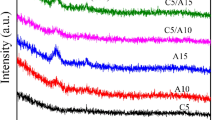Abstract
The conductive and transparent properties of ZnO/Cu/ZnO sandwich structures were investigated in this study. The I–V curves of single ZnO films with different thicknesses were recorded and plotted. The linear I–V curves confirmed the ohmic conduction mechanism for the ZnO thin films in the ZnO/Cu/ZnO sandwich structures. Moreover, the energy band diagram of the ZnO/Cu interface showed that the interface between ZnO and Cu exhibited ohmic contact behavior. The resistivity of the ZnO/Cu/ZnO sandwich structures (with thicknesses between 20/5/20 nm and 80/5/80 nm) ranged from 2.25 × 10−4 Ω cm to 9.72 × 10−4 Ω cm. The lowest resistivity (i.e., 2.25 × 10−4 Ω cm) occurred in the 20/5/20 nm thin film. In the ZnO/Cu/ZnO sandwich structures, the electrons are transported vertically through the upper ZnO thin film and transported horizontally in the sandwiched Cu thin film. Ohmic conduction behavior was verified throughout the conduction path in the ZnO/Cu/ZnO sandwich structure. The transmittance measurement in the visible region of the structures showed that the sandwiched ZnO layers increased the transmittance of the 5 nm Cu thin film. In addition, the transmittance of the ZnO/Cu/ZnO sandwich structure was dependent on the thickness of the sandwiched ZnO layers. The 60/5/60 nm sandwich structure exhibited the best enhancement effect on transmittance. The thickness dependence was found to be due to the destructive interference between the reflected light at the ZnO/Cu and Cu/ZnO interfaces in the ZnO/Cu/ZnO sandwich structures.
Similar content being viewed by others
References
J. Tamayo-Arriola, A. Huerta-Barbera, M. Montes Bajo, E. Munoz, V. Munoz-Sanjose, and A. Hierro, Appl. Phys. Lett. (2018). https://doi.org/10.1063/1.5048771.
J. Ephraim, D. Lanigan, C. Staller, D.J. Milliron, and E. Thimsen, Chem. Mater. (2016). https://doi.org/10.1021/acs.chemmater.6b02414.
H. Hajibabaei, O. Zandi, and T.W. Hamann, Chem. Sci. (2016). https://doi.org/10.1039/c6sc02116f.
A. Zeumault and V. Subramanian, Adv. Funct. Mater. (2016). https://doi.org/10.1002/adfm.201503940.
Y.R. Lu, Y.S. Xie, and Y.S. Zhang, Optolink (2012). https://doi.org/10.29664/Optolink.201203.0013.
K.H. Choi, H.J. Nam, J.A. Jeong, S.W. Cho, H.K. Kim, J.W. Kang, D.G. Kim, and W.J. Cho, Appl. Phys. Lett. (2008). https://doi.org/10.1063/1.2937845.
Y.S. Park, K.H. Choi, and H.K. Kim, J. Phys. D Appl. Phys. (2009). https://doi.org/10.1088/0022-3727/42/23/235109.
C.C. Chueh, C.I. Chen, Y.A. Su, H. Konnerth, Y.J. Gu, C.W. Kung, and K.C.W. Wu, J. Mater. Chem. A (2019). https://doi.org/10.1039/C9TA03595H.
C.C. Lee, C.I. Chen, Y.T. Liao, K.C.W. Wu, and C.C. Chueh, Adv. Sci. (2019). https://doi.org/10.1002/advs.201801715.
Y.T. Liao, N.V. Chi, N. Ishiguro, A.P. Young, C.K. Tsung, and K.C.W. Wu, Appl. Catal. B (2020). https://doi.org/10.1016/j.apcatb.2020.118805.
H. Konnerth, B.M. Matsagar, S.S. Chen, M.H.G. Prechtl, F.K. Shieh, and K.C.W. Wu, Coord. Chem. Rev. (2020). https://doi.org/10.1016/j.ccr.2020.213319.
Y.T. Liao, B.M. Matsagar, and K.C.W. Wu, ACS Sustain. Chem. Eng. (2018). https://doi.org/10.1021/acssuschemeng.8b03683.
D.R. Sahu and J.L. Huang, Appl. Surf. Sci. (2006). https://doi.org/10.1016/j.apsusc.2006.01.023.
D.R. Sahu and J.L. Huang, Appl. Surf. Sci. (2006). https://doi.org/10.1016/j.apsusc.2006.01.035.
D.R. Sahu, S.Y. Lin, and J.L. Huang, Microelectron. J. (2007). https://doi.org/10.1016/j.mejo.2006.11.005.
D.R. Sahu and J.L. Huang, Thin Solid Films 516, 208 (2007). https://doi.org/10.1016/j.tsf.2007.06.124.
D.R. Sahu and J.L. Huang, Microelectron. J. (2007). https://doi.org/10.1016/j.mejo.2007.01.012.
K. Sivaramakrishnan, N.D. Theodore, J.F. Moulder, and T.L. Alford, J. Appl. Phys. (2009). https://doi.org/10.1063/1.3213385.
H.C. Lee and O.O. Park, Vacuum (2004). https://doi.org/10.1016/j.vacuum.2004.03.008.
M.D. McCluskey and S.J. Jokela, J. Appl. Phys. (2009). https://doi.org/10.1063/1.3216464.
I. Miccoli, F. Edler, H. Pfnür, and C. Tegenkamp, J. Phys. Condens. Matter (2015). https://doi.org/10.1088/0953-8984/27/22/223201.
C. Guillen and J. Herrero, Thin Solid Films (2011). https://doi.org/10.1016/j.tsf.2011.06.091.
T. Zhou and D. Gall, Phys. Rev. B (2018). https://doi.org/10.1103/PhysRevB.97.165406.
F.C. Chiu, Adv. Mater. Sci. Eng. (2014). https://doi.org/10.1155/2014/578168.
C.C. Lee, Thin Film Optics and Coating Technology, 8th ed. (Taipei: Yi Hsien, 2016), pp. 41–45.
K.M. McPeak, S.V. Jayanti, S.J. Kress, S. Meyer, S. Iotti, A. Rossinelli, and D.J. Norris, ACS Photonics 2, 326 (2015). https://doi.org/10.1021/ph5004237.
M.F. Al-Kuhaili, I.O. Alade, and S.M.A. Durrani, Opt. Mater. Express (2014). https://doi.org/10.1364/OME.4.002323.
H.K. Raut, V.A. Ganesh, A.S. Nair, and S. Ramakrishna, Energy Environ. Sci. (2011). https://doi.org/10.1039/c1ee01297e.
Acknowledgments
This study was supported in part by the Programs MOST107-2221-E-008-042-MY3 and MOST108-2221-E-008-045-MY3. Financial support and information consultancy regarding high and flexible material development trends provided by Zhen Ding Technology Holding Limited is also greatly appreciated.
Author information
Authors and Affiliations
Corresponding author
Ethics declarations
Conflict of interest
The authors declare that they have no conflict of interest.
Additional information
Publisher's Note
Springer Nature remains neutral with regard to jurisdictional claims in published maps and institutional affiliations.
Rights and permissions
About this article
Cite this article
Chen, WH., Chou, CY., Li, BJ. et al. Conductive and Transparent Properties of ZnO/Cu/ZnO Sandwich Structure. J. Electron. Mater. 50, 779–785 (2021). https://doi.org/10.1007/s11664-020-08471-6
Received:
Accepted:
Published:
Issue Date:
DOI: https://doi.org/10.1007/s11664-020-08471-6




